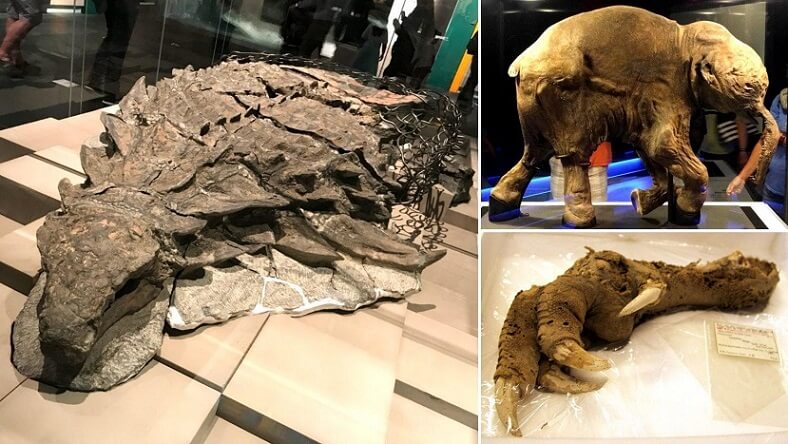By N. Hale | Ancient Mysteries
Fossils are formed in different ways, but most are formed when a plant or animal dies in a watery environment and is buried in mud and silt. Soft tissues quickly decompose leaving the hard bones or shells behind. Over time sediment builds over the top and hardens into rock. It is when the processes of erosion occur that these secrets in stone are revealed to us.
But there are some prehistorically finds that defy this conventional theory of fossil and procedure of fossilization. These great findings have made scientists astounded because they are beyond any traditional archaeological discovery. They are so well-preserved and in so exquisite conditions that they make us believe they once somehow froze in time.
This isn’t a dinosaur fossil; it’s a mummy. Scientists think the 110 million-year-old nodosaur was swept to sea by a flooding river, sank, landed on its back, and was pressed into the ocean floor. It’s so well-preserved that it still has intestines and weighs 2,500 of its original 3,000 lbs. This prehistoric, armoured plant-eater is the best preserved fossil of its kind ever found.
Dogor, an 18,000 years old pup was found frozen in Siberia. The remains of this prehistoric animal are puzzling researchers because genetic testing shows it’s neither a wolf nor a dog, meaning it could be an elusive ancestor of both.
The thing scientists discovered was a perfectly preserved claw that still had flesh and muscles attached to it. It’s a preserved Megalapteryx foot ― the last Moa species to become extinct. For millions of years, nine species of these large, flightless birds known as Moas (Dinornithiformes) thrived in New Zealand. Then, about 600 years ago, they abruptly went extinct, shortly after humans arrived in New Zealand in the 13th century.
The mammoth named Lyuba was discovered in 2007 by a Siberian herder and his two sons. Lyuba is a one-month-old woolly mammoth that died nearly 42,000 years ago. She was found with her skin and organs intact, and her mother’s milk still in her stomach. She is the most complete mammoth ever discovered, and is teaching scientists more about why her species went extinct.
During the summer of 1976, the Rumans, a family of miners, discovered an incredibly preserved carcass of a male steppe bison embedded in ice near the city of Fairbanks, Alaska. They named it Blue Babe. It’s a 36,000 years old steppe bison that once roamed the mammoth steppe, along with ancient horses, wooly mammoths, and wooly rhinoceroses. Blue Babe is on display at the University of Alaska Museum of the North in Fairbanks. These majestic, long-horned creatures went extinct some 8,000 years ago, during the early period of the Holocene — the current geological epoch.
Over a century ago, a father-son team of paleontologists (the Sternbergs) uncovered an exceptionally well-preserved Edmontosaurus hadrosaur in the deserts of Wyoming, the United States. The preservation quality was so astounding that skin, ligaments, and various other articles of soft tissue were in enough well-condition to conduct an in-depth research. The Edmontosaurus mummy is officially known as AMNH 5060, which is now in the collection of the American Museum of Natural History (AMNH).
Scientists found a 42,000 years old foal in Siberia. It still had liquid blood. This is the oldest blood in the world. Called the Lena horse, this ice age foal was found in the Batagaika Crater in eastern Siberia and is thought to have been just two months old when it died, likely by drowning in mud.
Yuka, a mummified woolly mammoth that roamed on earth around 39,000 years back into the past. Yuka was found in the Siberian permafrost and was between six to eleven years old when she died. It is one of the best preserved mammoths in the history of paleontology. Yuka stayed in such good condition because she remained frozen for a long, unbroken period of time.
The mammoth fell into water or got bogged down in a swamp, could not free herself and died. Due to this fact the lower part of the body, including the lower jaw and tongue tissue, was preserved very well. The upper torso and two legs, which were in the soil, were gnawed by prehistoric and modern predators and almost did not survive. Although the carcass was frozen for millennia, scientists were even able to extract flowing blood from Yuka.
* * *
Bonus
Valley of the Whales
Wadi Al-Hitan, Whale Valley, in the Western Desert of Egypt, contains invaluable fossil remains of the earliest, and now extinct, suborder of whales. It was designated a UNESCO World Heritage Site in July 2005 for its hundreds of fossils of some of the earliest forms of whale, the archaeoceti.

